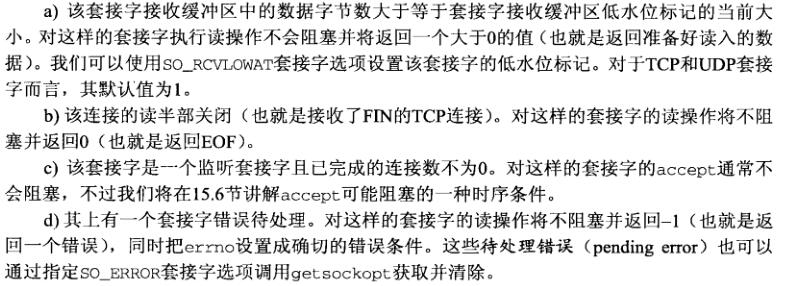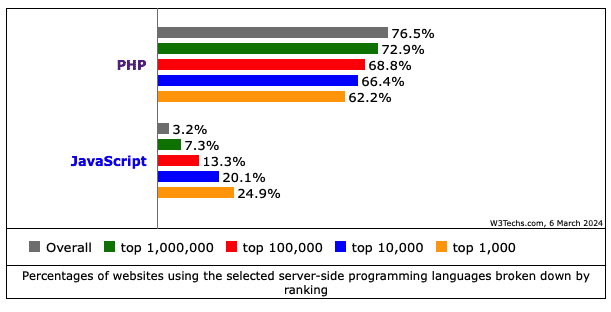要理解select.select模块其实主要就是要理解它的参数, 以及其三个返回值。
select()方法接收并监控3个通信列表, 第一个是所有的输入的data,就是指外部发过来的数据,第2个是监控和接收所有要发出去的data(outgoing data),第3个监控错误信息
在网上一直在找这个select.select的参数解释, 但实在是没有, 哎…自己硬着头皮分析了一下。
readable, writable, exceptional = select.select(inputs, outputs, inputs)
select 函数的参数其实很好理解, 前提是我们对unix 网络编程有了解. select 模型是unix 系统中的网络模型, python 将其封装了,因此我们使用起来就比较方便, 但是面试官就不会这么觉得了(最近被面试逼疯了, 考虑问题都从面试官的角度考虑), 先说下unix 系统中的select 模型吧, 参数原型:
int select(int maxfdpl, fd_set * readset, fd_set *writeset, fd_set *exceptset, const struct timeval * tiomeout)
第一个是最大的文件描述符长度
第二个是监听的可读集合
第三个是监听的可写集合
第四个是监听的异常集合
第五个是时间限制
对struct fd_set结构体操作的宏
FD_SETSIZE 容量,指定fd_array数组大小,默认为64,也可自己修改宏
FD_ZERO(*set) 置空,使数组的元素值都为3435973836,元素个数为0.
FD_SET(s, *set) 添加,向 struct fd_set结构体添加套接字s
FD_ISSET(s, *set) 判断,判断s是否为 struct fd_set结构体中的一员
FD_CLR(s, *set) 删除,从 struct fd_set结构体中删除成员s
因为此模型主要是在网络中应用, 我们不考虑文件, 设备, 单从套接字来考虑, 可读条件如下:

可写条件如下:

我看C 示例的时候, 看的有点懵逼, 应该需要跑一遍代码就好, python 就简单了, 直接调用封装好的select , 其底层处理好了文件描述符的相关读写监听(回头再研究下), 我们在Python 中只需这么写:
can_read, can_write, _ = select.select(inputs, outputs, None, None)
第一个参数是我们需要监听可读的套接字, 第二个参数是我们需要监听可写的套接字, 第三个参数使我们需要监听异常的套接字, 第四个则是时间限制设置.
如果监听的套接字满足了可读可写条件, 那么所返回的can,read 或是 can_write就会有值了, 然后我们就可以利用这些返回值进行随后的操作了。相比较unix 的select模型, 其select函数的返回值是一个整型, 用以判断是否执行成功.
第一个参数就是服务器端的socket, 第二个是我们在运行过程中存储的客户端的socket, 第三个存储错误信息。
重点是在返回值, 第一个返回的是可读的list, 第二个存储的是可写的list, 第三个存储的是错误信息的
list。
网上所有关于select.select的代码都是差不多的, 但是有些不能运行, 或是不全。我自己重新写了一份能运行的程序, 做了很多注释, 好好看看就能搞懂
服务器端:
# coding: utf-8
import select
import socket
import Queue
from time import sleep# Create a TCP/IP
server = socket.socket(socket.AF\_INET, socket.SOCK\_STREAM)
server.setblocking(False)# Bind the socket to the port
server\_address = ('localhost', 8090)
print ('starting up on %s port %s' % server\_address)
server.bind(server\_address)# Listen for incoming connections
server.listen(5)# Sockets from which we expect to read
inputs = \[server\]# Sockets to which we expect to write
# 处理要发送的消息
outputs = \[\]# Outgoing message queues (socket: Queue)
message\_queues = {}while inputs:# Wait for at least one of the sockets to be ready for processingprint ('waiting for the next event')# 开始select 监听, 对input\_list 中的服务器端server 进行监听 # 一旦调用socket的send, recv函数,将会再次调用此模块readable, writable, exceptional = select.select(inputs, outputs, inputs)# Handle inputs# 循环判断是否有客户端连接进来, 当有客户端连接进来时select 将触发for s in readable:# 判断当前触发的是不是服务端对象, 当触发的对象是服务端对象时,说明有新客户端连接进来了# 表示有新用户来连接if s is server:# A "readable" socket is ready to accept a connectionconnection, client\_address = s.accept()print ('connection from', client\_address)# this is connection not serverconnection.setblocking(0)# 将客户端对象也加入到监听的列表中, 当客户端发送消息时 select 将触发inputs.append(connection)# Give the connection a queue for data we want to send# 为连接的客户端单独创建一个消息队列,用来保存客户端发送的消息message\_queues\[connection\] = Queue.Queue()else:# 有老用户发消息, 处理接受# 由于客户端连接进来时服务端接收客户端连接请求,将客户端加入到了监听列表中(input\_list), 客户端发送消息将触发# 所以判断是否是客户端对象触发data = s.recv(1024)# 客户端未断开if data != '':# A readable client socket has dataprint ('received "%s" from %s' % (data, s.getpeername()))# 将收到的消息放入到相对应的socket客户端的消息队列中message\_queues\[s\].put(data)# Add output channel for response# 将需要进行回复操作socket放到output 列表中, 让select监听if s not in outputs:outputs.append(s)else:# 客户端断开了连接, 将客户端的监听从input列表中移除# Interpret empty result as closed connectionprint ('closing', client\_address)# Stop listening for input on the connectionif s in outputs:outputs.remove(s)inputs.remove(s)s.close()# Remove message queue# 移除对应socket客户端对象的消息队列del message\_queues\[s\]# Handle outputs# 如果现在没有客户端请求, 也没有客户端发送消息时, 开始对发送消息列表进行处理, 是否需要发送消息# 存储哪个客户端发送过消息for s in writable:try:# 如果消息队列中有消息,从消息队列中获取要发送的消息message\_queue = message\_queues.get(s)send\_data \= ''if message\_queue is not None:send\_data \= message\_queue.get\_nowait()else:# 客户端连接断开了print "has closed "except Queue.Empty:# 客户端连接断开了print "%s" % (s.getpeername())outputs.remove(s)else:# print "sending %s to %s " % (send\_data, s.getpeername)# print "send something"if message\_queue is not None:s.send(send\_data)else:print "has closed "# del message\_queues\[s\]# writable.remove(s)# print "Client %s disconnected" % (client\_address)# # Handle "exceptional conditions"# 处理异常的情况for s in exceptional:print ('exception condition on', s.getpeername())# Stop listening for input on the connectioninputs.remove(s)if s in outputs:outputs.remove(s)s.close()# Remove message queuedel message\_queues\[s\]sleep(1)
客户端:
# coding: utf-8
import socketmessages \= \['This is the message ', 'It will be sent ', 'in parts ', \]server\_address \= ('localhost', 8090)# Create aTCP/IP socket
socks \= \[socket.socket(socket.AF\_INET, socket.SOCK\_STREAM), socket.socket(socket.AF\_INET, socket.SOCK\_STREAM), \]# Connect thesocket to the port where the server is listeningprint ('connecting to %s port %s' % server\_address)
# 连接到服务器
for s in socks:s.connect(server\_address)for index, message in enumerate(messages):# Send messages on both socketsfor s in socks:print ('%s: sending "%s"' % (s.getsockname(), message + str(index)))s.send(bytes(message \+ str(index)).decode('utf-8'))# Read responses on both socketsfor s in socks:data \= s.recv(1024)print ('%s: received "%s"' % (s.getsockname(), data))if data != "":print ('closingsocket', s.getsockname())s.close()
写代码过程中遇到了两个问题, 一是如何判断客户端已经关闭了socket连接, 后来自己分析了下, 如果关闭了客户端socket, 那么此时服务器端接收到的data就是’', 加个这个判断。二是如果服务器端关闭了socket, 一旦在调用socket的相关方法都会报错, 不管socket是不是用不同的容器存储的(意思是说list_1存储了socket1, list_2存储了socket1, 我关闭了socket1, 两者都不能在调用这个socket了)
服务器端:

客户端:

最后,如果你也想自学Python,可以关注我。
我还整理出了一套系统的学习路线,这套资料涵盖了诸多学习内容: 【扫描下方】领取!

包括:Python激活码+安装包、Python web开发,Python爬虫,Python数据分析,人工智能、自动化办公等学习教程。带你从零基础系统性的学好Python!开发工具,基础视频教程,项目实战源码,51本电子书籍,100道练习题等。相信可以帮助大家在最短的时间内,能达到事半功倍效果,用来复习也是非常不错的。





















